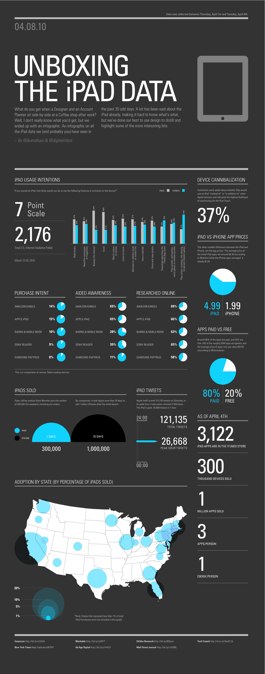 |
|
An Interesting InfoGraphic done by graphic artist John Kumahara |
It’s with some apology that I use the term “technology-infused.” At Educon in January, Chris Lehman used the term in one of his sessions, and upon asking us to discuss his posed question, I mentioned to the small group I was with my dislike for the term, after which one of the members, put on the spot to share something that we’d discussed, said, “Well David Warlick said he doesn’t even like the term.” Yikes!
It’s a good term. It’s just that using techno-centric terms tends to give people an underdeveloped idea of what our goal really is, which I would suggest is just what could happen (is happening) with the recent launch of Apple’s iPad. In Colleges Dream of Paperless, iPad-centric Education, author Brian X. Chen reports on three universities that are..
..getting pumped to hand out free iPads to students and faculty with hopes that Apple’s tablet will revolutionize education.
All three pre-ordered bundles of iPads, believing that they represent a potential end to printed textbooks. Among the advantages of the iPad (and tablets in general),
- Faculty will be able to use more of a variety of textbooks, since digital versions will be less expensive.
- The iPad will likely not have the limitations that disappointed students who were involved in an e-textbook pilot at Princeton, using the Amazon Kindle DX.
Even though Apple has yet to announce any deals with textbook publishers (only popular ebooks), a third-party company currently offers 10,000 e-textbooks, which include titles from the five biggest textbook publishers. A subscription-based service, registered students can access the e-textbooks of their choice for a limited amount of time. The company has already announced an iPad app.
Forrester analyst, Sara Rotman, said that,
The iPad has far greater potential to succeed as an educational device than Amazon’s Kindle DX. Where the Kindle is sluggish, monochrome and limited in interactivity features, the iPad is fast, sports a colorful touchscreen and supports enough apps to cater to a broad audience of students.
“Cell phones and PDAs do not seem to be the primary device of choice that students want to bring with them into the classroom.” That’s what George Fox University found, when they piloted iPhones and iPod Touch devices, intending teachers to integrate apps into their curricula.
“We think the iPad will become the device students carry with them everywhere, and the laptop will become the base station in their dorm room,” said Greg Smith, chief information officer of George Fox University. “The iPad becomes the mobile learning device.”
Abilene Christian drew a different conclusion, where Bill Rankin, a medieval studies professor, called the iPhone program the “TiVoing of education,” because the iPhone enabled students to access to the information whenever and wherever they want it.
Rankin said,
This is really about people re-imagining what books look like — re-imagining something that hasn’t really been re-imagined in about 550 years.
I just hope that we use enough imagination.
I guess I have one real questions.
As we try to re-imagine how new, game-changing, technologies,
Should we be using textbooks and classrooms as the templates for our new visions — imitating “instruction”,
or
Should we be using something else as the template — the learning that we are all engaged in during a time of rapid change. Might we create a lifelong learning model, and aim our tech at that?

This week I had the opportunity to visit and observe the Manor HS new Technological Academy. The academy is a math/science focused school that has strictly a PBL (problem or project based learning) curriculum.
I was NOT impressed at all with this new school nor do I believe the claims they make. Further, I believe that ANY school, in any district in Texas today, can do the exact same things they have done and claim the exact same results. This is due to how they select their students, how they have structured their curriculum and how they are actually practicing their model.
I have published a longer critique at http://www.janseiter.com
I think it is backwards thinking to look at one technology as somehow being THE answer-we all learn so differently-why do we continue to thing that EVERYONE should have the same learning tools. Institutions have NO business dictating what platforms and hardware should be utilized…they should take a hardware, software, and OS agnostic approach to technologies and design an ecosystem where content may be consumed and produced from ANY (or MOST any) IP enabled device.
I like what Gever Tulley says, “Create pedagogy that integrates technologies as quickly as they emerge.” http://www.flickr.com/photos/mjmonty/4451394507/in/pool-858082@N25
This is a comment for the post above, actually- am being cheeky and supposing you left comments off by accident!
It had honestly never occured to me that high staff turnover could be a good thing. Our school actively encourages people to move to branches in other countries, and I’d always cynically assumed it was to stop people expecting job security, being able to unionize etc. Think you might have a point though
It is helpful to us.
Your Information is not be good.
Now,technology will come very good.
Thank You.